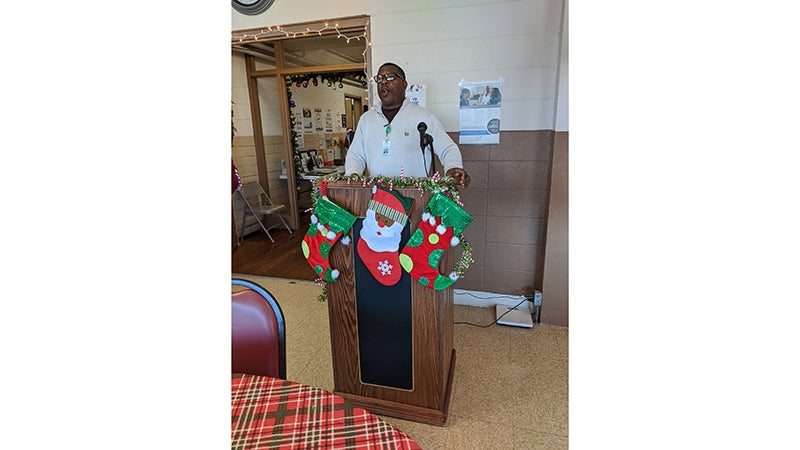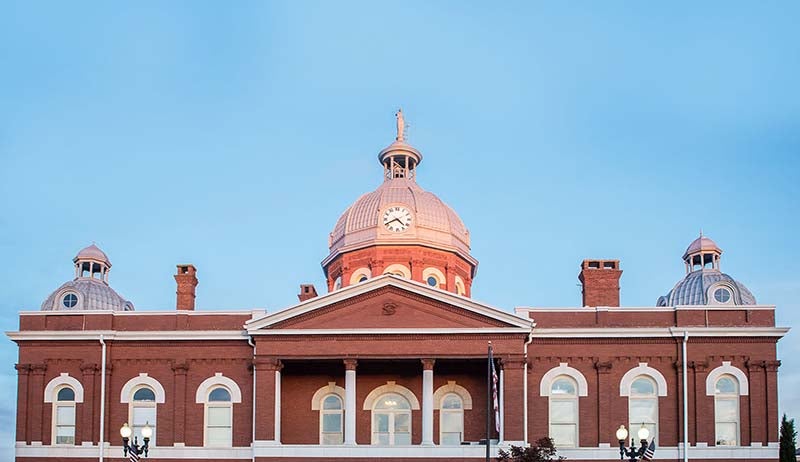WHAT’S IN A NAME? City of Lanett
Published 2:00 pm Saturday, February 25, 2023
|
Getting your Trinity Audio player ready...
|
LANETT — With an estimated population of 7,120 people, Lanett is the 92nd largest city in the state of Alabama. The area has been settled by people of European descent since the early 1800s. The first permanent resident on this west side of the Chattahoochee River was a man named William Moore. He was married to a Creek Indian woman and ran a grist mill, trading post and grog shop along the banks of a stream that bears his name today. There’s a street in the Brookwood II subdivision that’s named after his mill.
What’s now known as Lanett was once called Stanleyville after an early settler, Jesse Stanley, who at one time owned much of the land where Lanett developed. The largest landowner on the Alabama side was a man named George Reese, who had a plantation on what’s now the northwest side of town. Many of the pecan trees that are so abundant in Lanett are descended from trees planted on the Reese Plantation. Many of those who lived on the Reese Plantation lie at rest in a family cemetery known as Hopewell. It’s a short walk away from Springwood School. The graves include some people who were born in the 1700s, including George Reese.
No one knows for sure how the name Bluffton cane about, but almost certainly it’s because the area just over the state line from West Point is of higher elevation and out of a flood zone that caused much misery for the downtown area for many years. A number of prominent merchants in the downtown area had homes on the bluff. What’s now North 14th Street in Lanett was Heyman Street when Bluffton was chartered as a city in December 1865. Many of those who had homes on Heyman Street were of the Jewish faith. In 1859, they organized a synagogue, Temple Beth El, which had services for close to 100 years.
These Bluffton residents had names such as Heyman, Merz, Hagedorn, Friesleben, Sterne and Herzfeld. They were among many European Jews who immigrated to the United States in the 1800s to avoid the persecution they had long endured in the old country.
In the 1860s, the Merz family ran a tannery on a nearby stream where they made leather goods for the Confederate army. This is what gave a name to Tanyard Creek.
A member of the Merz family, Louis Merz, was killed in the Civil War Battle of Antietam, which has often been called the Bloodiest Day in American History.
An 1877 map of Bluffton shows a triangle formed by Bluffton Street on the south, Lanier Street on the west and Gordon Street on the east side. There was a female academy on the southeast corner of the triangle and a spring forming a small branch that flowed to Tanyard Creek.
The triangle is today a landmark feature of the city. It’s flanked by First Street to the south, North Lanier Avenue to the west and North 4th Avenue on the east side. There’s a beautiful blue fountain in the middle.
On the map, North Lanier Avenue follows the same path Lanier Street did back then. It crosses Tanyard Creek, but where the road takes a bend to the left it becomes Jackson Street before intersecting with Cherry Street near the Georgia state line. Cherry Street is now known as Cherry Drive and is named for a well-known local family in Bluffton/Lanett.
One member of the family, Charlotte Elmore Cherry, had an eventful year in 1865. She witnessed the Civil War Battle of West Point, got married and was living in the town the year it was chartered as a city. Her husband, George N. Croft, was the final mayor of Bluffton and the first mayor of Lanett. He served between 1893 and 1897. Bluffton changed its name to Lanett in 1895.
Charlotte Cherry was 17 years old in 1865. She lived in the family home on Ward Street, which was near the present-day location of the Holy Family Catholic Church. On the morning of Easter Sunday, April 16, 1865, she got the news that Union Calvary was on the way to West Point. Their goal was to capture and destroy the railyard and any rolling stock they could find, rip up the rails and burn the two bridges that crossed the Chattahoochee River.
Charlotte feared the dreaded yankees might loot her beloved Christ Church, the forerunner of West Point Presbyterian. She rushed to the church (located where Sweet Georgia Brown is today), gathered anything of value she could find and hid it under the front steps to the church. The silver service that was used during communion is among the items saved by Charlotte. It’s now one of West Point Presbyterian’s most treasured items.
The Battle of West Point ended in a Union victory over an outmanned but brave group of Fort Tyler defenders made up mostly of teenage boys, old men and soldiers convalescing from their wounds. Charlotte Cherry joined West Point women in being of what help she could to treat wounded soldiers. The Union had seven killed and 29 wounded. The Confederates had 19 killed, 28 wounded and 218 captured.
The state line ran through the middle of the fort, partly in West Point and partly in Bluffton. It was built on a high point of land and had cannons to protect against an invading army.
Jackson is a prominent name in the history of Bluffton/Lanett. Jackson Hill has been a well-known name throughout the history of the town. On the morning of April 16, 1865, Union calvary selected it as a place to fire on Fort Tyler. They were part of Wilson’s Raiders who were sweeping across Alabama after defeating General Nathan Bedford Forrest a few days earlier in Selma. The 1877 map of Bluffton has a Jackson Street and a Jackson residence.
In 1931, an African-American school was built on Jackson Hill at a site known as the Dallas Jackson Place. It was known as Lanier High. S.Q. Bryant was its principal from 1938-1954. L. B. Sykes was the principal from 1954 until the school closed with desegregation in 1969. Sykes was the first football coach at Lanier High. He was succeeded by James Hardy when he became principal.
Other Bluffton streets had such names as Harper, Trammell, Stonewall, Reese, Railroad and Pine Street. A railroad reached Bluffton in 1851. It came north from Montgomery to meet a railroad coming south from Atlanta. The Georgia part of the railroad reached West Point in 1854.
The 1877 map shows places known as Chattahoochee House and the car shed across the state line in West Point. Chattahoochee House was the name of a hotel, mostly used by those traveling by rail. The car shed went up near the state line as a place to store locomotives in bad weather. What made West Point such an inviting target for the Union calvary was what was known as the narrow gauge. The distance between one rail to the other was different in each state. A train could run to the state line but not into the next state. This meant offloading cargo into warehouses, having it loaded onto carts and carried across the state line onto a train in the next state.
There also had to be turntables where the locomotives could be turned around to head back to Montgomery or Atlanta.
The name “Lanett” dates to 1892. The Lan is for Lafayette Lanier and the “ett” for Theodore Bennett. Lanier was the president of the West Point Manufacturing Company and Bennett was with the Wellington Sears sales agency, which marketed goods manufactured in the West Point Manufacturing Company mills all over the U.S.
At the outset of the company in 1880, WPMC had mills in River View and Langdale. Lanett Mill would be the first new plant built by the c0mpany. Construction on what became Lanett Cotton Mills, Inc. began in 1892. A four-floor building known as Unit One was completed in two years, and the first yard of cloth rolled off the looms in 1894. The mill was so successful that a second four-story building was built. It went into production in 1900. Each unit had a four-story tower facing Gilmer Street and an even taller smokestack in the back. The Chattahoochee Valley (CV) Railway, which went into service in 1895, ran in front of the mill. A brick shelter that still stands today was built to pick up mill workers leaving the mill at the end of their shift and take them closer to their homes.
The construction of the Lanett mill village in the 1890s led to a rapid growth of the city’s population. Bluffton had a few hundred people in 1890, but Lanett had 2,500 in 1900.
The portion of Highway 29 that runs through Lanett to the Overhead Bridge is today known as Gilmer Avenue. It was built in the early 1890s to connect West Point to the new mill. The street in West Point was named for George Rockingham Gilmer (1790-1859), who was governor of Georgia in the 1830s, when West Point became a city. He had a brother, William Benjamin Strother Gilmer, who owned a 400-acre farm north of West Point. The farm straddled the state line, some in Georgia and some in Alabama.
Lanett could be reached on the north side of town on a road from the Fredonia community. In the 1870s, the road crossed Oseligee Creek in a covered bridge built by Horace King. It’s the only known record of a bridge built in Chambers County by the master builder of the covered bridge. There were a number of them in Troup County, including the original wagon bridge in West Point, which was built in 1839. This bridge was burned by Union troops the day after the Battle of Fort Tyler. It was replaced by another bridge that washed away in the flood of 1886. The next bridge was washed away in the flood of 1919.
On the west and southwest sides of town, roads reached Lanett from LaFayette and Cusseta.
An area on the south side of Lanett has been known as Plant City since 1939. It’s named in honor of Jack Plant, who owned and operated a grocery store on the site where Captain D’s is located today. He lived in a home off Highway 29 in Plant City where an Exxon station is located today. The spacious two-story home had previously been owned by Dr. A.C. Smith, an ophthalmologist who “accurately, scientifically and attractively” fitted glasses.





